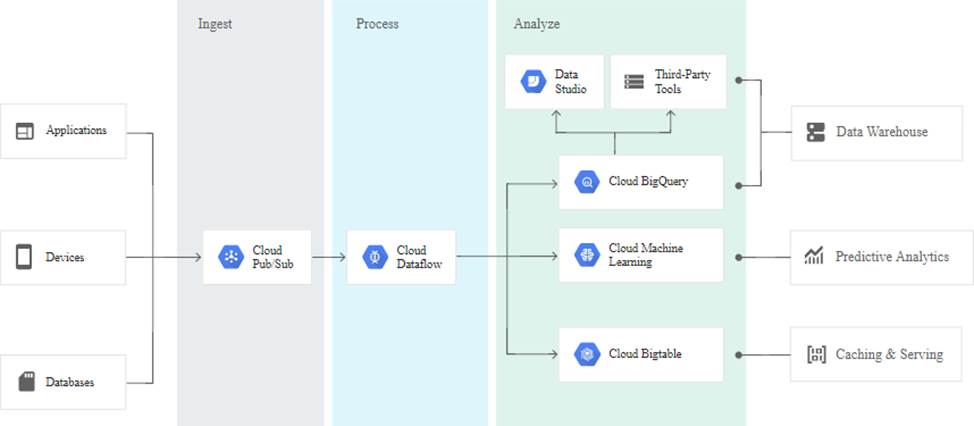Google Professional Cloud Architect Google Certified Professional – Cloud Architect (GCP) Online Training
Google Professional Cloud Architect Online Training
The questions for Professional Cloud Architect were last updated at Dec 17,2025.
- Exam Code: Professional Cloud Architect
- Exam Name: Google Certified Professional – Cloud Architect (GCP)
- Certification Provider: Google
- Latest update: Dec 17,2025
Topic 1, Mountkirk Games Case Study 1
Company Overview
Mountkirk Games makes online, session-based, multiplayer games for the most popular mobile platforms.
Company Background
Mountkirk Games builds all of their games with some server-side integration, and has historically used cloud providers to lease physical servers. A few of their games were more popular than expected, and they had problems scaling their application servers, MySQL databases, and analytics tools.
Mountkirk’s current model is to write game statistics to files and send them through an ETL tool that loads them into a centralized MySQL database for reporting.
Solution Concept
Mountkirk Gamesis building a new game, which they expect to be very popular. They plan to deploy the game’s backend on Google Compute Engine so they can capture streaming metrics, run intensive analytics, and take advantage of its autoscaling server environment and integrate with a managed NoSQL database.
Technical Requirements
Requirements for Game Backend Platform
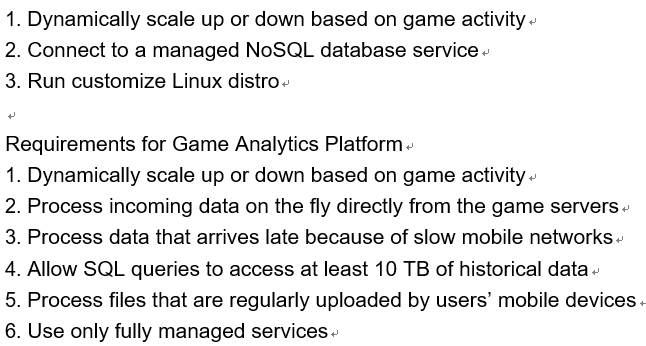
CEO Statement
Our last successful game did not scale well with our previous cloud provider, resulting in lower user adoption and affecting the game’s reputation. Our investors want more key performance indicators (KPIs) to evaluate the speed and stability of the game, as well as other metrics that provide deeper insight into usage patterns so we can adapt the game to target users.
CTO Statement
Our current technology stack cannot provide the scale we need, so we want to replace MySQL and move to an environment that provides autoscaling, low latency load balancing, and frees us up from managing physical servers.
CFO Statement
We are not capturing enough user demographic data, usage metrics, and other KPIs. As a result, we do not engage the right users, we are not confident that our marketing is targeting the right users, and we are not selling enough premium Blast-Ups inside the games, which dramatically impacts our revenue.
For this question, refer to the Mountkirk Games case study.
Mountkirk Games wants you to design their new testing strategy .
How should the test coverage differ from their existing backends on the other platforms?
- A . Tests should scale well beyond the prior approaches.
- B . Unit tests are no longer required, only end-to-end tests.
- C . Tests should be applied after the release is in the production environment.
- D . Tests should include directly testing the Google Cloud Platform (GCP) infrastructure.
For this question, refer to the Mountkirk Games case study.
Mountkirk Games wants to set up a real-time analytics platform for their new game. The new platform must meet their technical requirements .
Which combination of Google technologies will meet all of their requirements?
- A . Container Engine, Cloud Pub/Sub, and Cloud SQL
- B . Cloud Dataflow, Cloud Storage, Cloud Pub/Sub, and BigQuery
- C . Cloud SQL, Cloud Storage, Cloud Pub/Sub, and Cloud Dataflow
- D . Cloud Dataproc, Cloud Pub/Sub, Cloud SQL, and Cloud Dataflow
- E . Cloud Pub/Sub, Compute Engine, Cloud Storage, and Cloud Dataproc
For this question, refer to the Mountkirk Games case study.
Mountkirk Games’ gaming servers are not automatically scaling properly. Last month, they rolled out a new feature, which suddenly became very popular. A record number of users are trying to use the service, but many of them are getting 503 errors and very slow response times .
What should they investigate first?
- A . Verify that the database is online.
- B . Verify that the project quota hasn’t been exceeded.
- C . Verify that the new feature code did not introduce any performance bugs.
- D . Verify that the load-testing team is not running their tool against production.
For this question, refer to the Mountkirk Games case study.
Mountkirk Games has deployed their new backend on Google Cloud Platform (GCP). You want to create a thorough testing process for new versions of the backend before they are released to the public. You want the testing environment to scale in an economical way .
How should you design the process?
- A . Create a scalable environment in GCP for simulating production load.
- B . Use the existing infrastructure to test the GCP-based backend at scale.
- C . Build stress tests into each component of your application using resources internal to GCP to simulate load.
- D . Create a set of static environments in GCP to test different levels of load ― for example, high, medium, and low.
For this question, refer to the Mountkirk Games case study.
Mountkirk Games wants to set up a continuous delivery pipeline. Their architecture includes many small services that they want to be able to update and roll back quickly.
Mountkirk Games has the following requirements:
• Services are deployed redundantly across multiple regions in the US and Europe.
• Only frontend services are exposed on the public internet.
• They can provide a single frontend IP for their fleet of services.
• Deployment artifacts are immutable.
Which set of products should they use?
- A . Google Cloud Storage, Google Cloud Dataflow, Google Compute Engine
- B . Google Cloud Storage, Google App Engine, Google Network Load Balancer
- C . Google Kubernetes Registry, Google Container Engine, Google HTTP(S) Load Balancer
- D . Google Cloud Functions, Google Cloud Pub/Sub, Google Cloud Deployment Manager
For this question, refer to the Mountkirk Games case study.
Mountkirk Games needs to create a repeatable and configurable mechanism for deploying isolated application environments. Developers and testers can access each other’s environments and resources, but they cannot access staging or production resources. The staging environment needs access to some services from production.
What should you do to isolate development environments from staging and production?
- A . Create a project for development and test and another for staging and production.
- B . Create a network for development and test and another for staging and production.
- C . Create one subnetwork for development and another for staging and production.
- D . Create one project for development, a second for staging and a third for production.
Topic 2, TerramEarth Case Study
Company Overview
TerramEarth manufactures heavy equipment for the mining and agricultural industries: about 80% of their business is from mining and 20% from agriculture. They currently have over 500 dealers and service centers in 100 countries. Their mission is to build products that make their customers more productive.
Company background
TerramEarth was formed in 1946, when several small, family owned companies combined to retool after World War II. The company cares about their employees and customers and considers them to be extended members of their family.
TerramEarth is proud of their ability to innovate on their core products and find new markets as their customers’ needs change. For the past 20 years, trends in the industry have been largely toward increasing productivity by using larger vehicles with a human operator.
Solution Concept
There are 20 million TerramEarth vehicles in operation that collect 120 fields of data per second. Data is stored locally on the vehicle and can be accessed for analysis when a vehicle is serviced. The data is downloaded via a maintenance port. This same port can be used to adjust operational parameters, allowing the vehicles to be upgraded in the field with new computing modules.
Approximately 200,000 vehicles are connected to a cellular network, allowing TerramEarth to collect data directly. At a rate of 120 fields of data per second with 22 hours of operation per day, Terram Earth collects a total of about 9 TB/day from these connected vehicles.
Existing Technical Environment
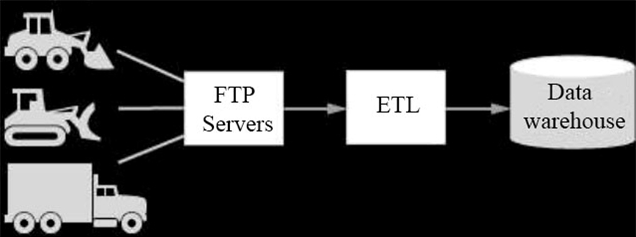
TerramEarth’s existing architecture is composed of Linux-based systems that reside in a data center. These systems gzip CSV files from the field and upload via FTP, transform and aggregate them, and place the data in their data warehouse. Because this process takes time, aggregated reports are based on data that is 3 weeks old.
With this data, TerramEarth has been able to preemptively stock replacement parts and reduce unplanned downtime of their vehicles by 60%. However, because the data is stale, some customers are without their vehicles for up to 4 weeks while they wait for replacement parts.
Business Requirements
– Decrease unplanned vehicle downtime to less than 1 week, without increasing the cost of carrying surplus inventory
– Support the dealer network with more data on how their customers use their equipment to better position new products and services
– Have the ability to partner with different companies C especially with seed and fertilizer suppliers in the fast-growing agricultural business C to create compelling joint offerings for their customers.
CEO Statement
We have been successful in capitalizing on the trend toward larger vehicles to increase the productivity of our customers. Technological change is occurring rapidly, and TerramEarth has taken advantage of connected devices technology to provide our customers with better services, such as our intelligent farming equipment. With this technology, we have been able to increase farmers’ yields by 25%, by using past trends to adjust how our vehicles operate. These advances have led to the rapid growth of our agricultural product line, which we expect will generate 50% of our revenues by 2020.
CTO Statement
Our competitive advantage has always been in the manufacturing process, with our ability to build better vehicles for lower cost than our competitors. However, new products with different approaches are constantly being developed, and I’m concerned that we lack the skills to undergo the next wave of transformations in our industry. Unfortunately, our CEO doesn’t take technology obsolescence seriously and he considers the many new companies in our industry to be niche players. My goals are to build our skills while addressing immediate market needs through incremental innovations.
For this question refer to the TerramEarth case study.
Which of TerramEarth’s legacy enterprise processes will experience significant change as a result of increased Google Cloud Platform adoption?
- A . Opex/capex allocation, LAN changes, capacity planning
- B . Capacity planning, TCO calculations, opex/capex allocation
- C . Capacity planning, utilization measurement, data center expansion
- D . Data Center expansion, TCO calculations, utilization measurement
For this question, refer to the TerramEarth case study.
TerramEarth has equipped unconnected trucks with servers and sensors to collet telemetry data. Next year they want to use the data to train machine learning models. They want to store this data in the cloud while reducing costs .
What should they do?
- A . Have the vehicle’ computer compress the data in hourly snapshots, and store it in a Google Cloud storage (GCS) Nearline bucket.
- B . Push the telemetry data in Real-time to a streaming dataflow job that compresses the data, and store it in Google BigQuery.
- C . Push the telemetry data in real-time to a streaming dataflow job that compresses the data, and store it in Cloud Bigtable.
- D . Have the vehicle’s computer compress the data in hourly snapshots, a Store it in a GCS Coldline bucket.
For this question, refer to the TerramEarth case study.
TerramEarth plans to connect all 20 million vehicles in the field to the cloud. This increases the volume to 20 million 600 byte records a second for 40 TB an hour .
How should you design the data ingestion?
- A . Vehicles write data directly to GCS.
- B . Vehicles write data directly to Google Cloud Pub/Sub.
- C . Vehicles stream data directly to Google BigQuery.
- D . Vehicles continue to write data using the existing system (FTP).
For this question, refer to the TerramEarth case study.
TerramEarth’s CTO wants to use the raw data from connected vehicles to help identify approximately when a vehicle in the development team to focus their failure. You want to allow analysts to centrally query the vehicle data .
Which architecture should you recommend?
A)
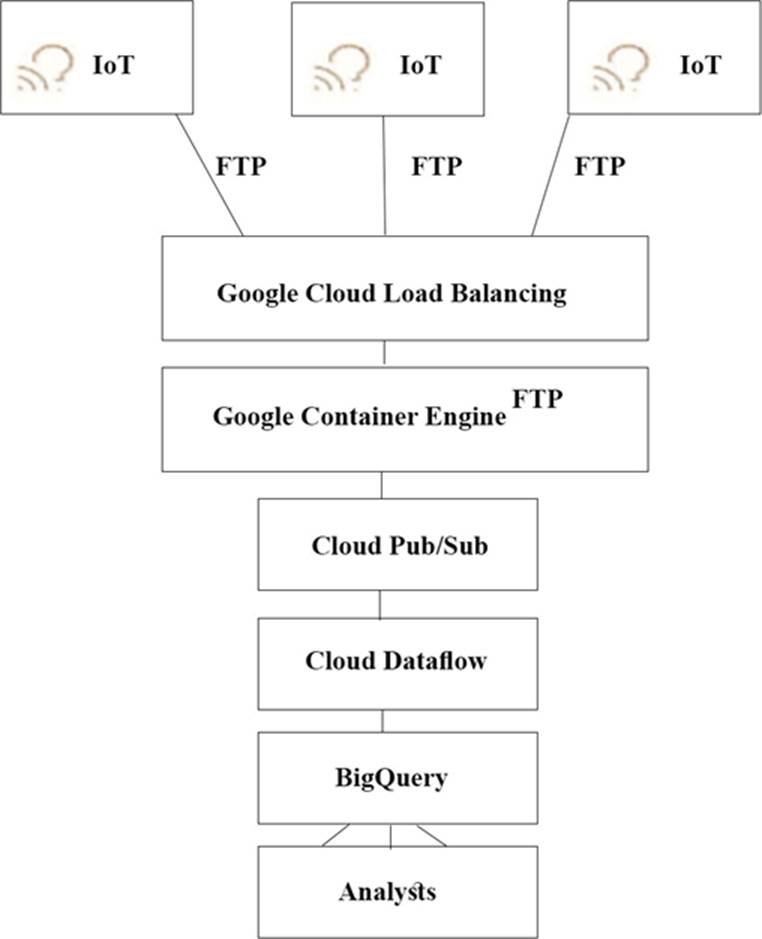
B)
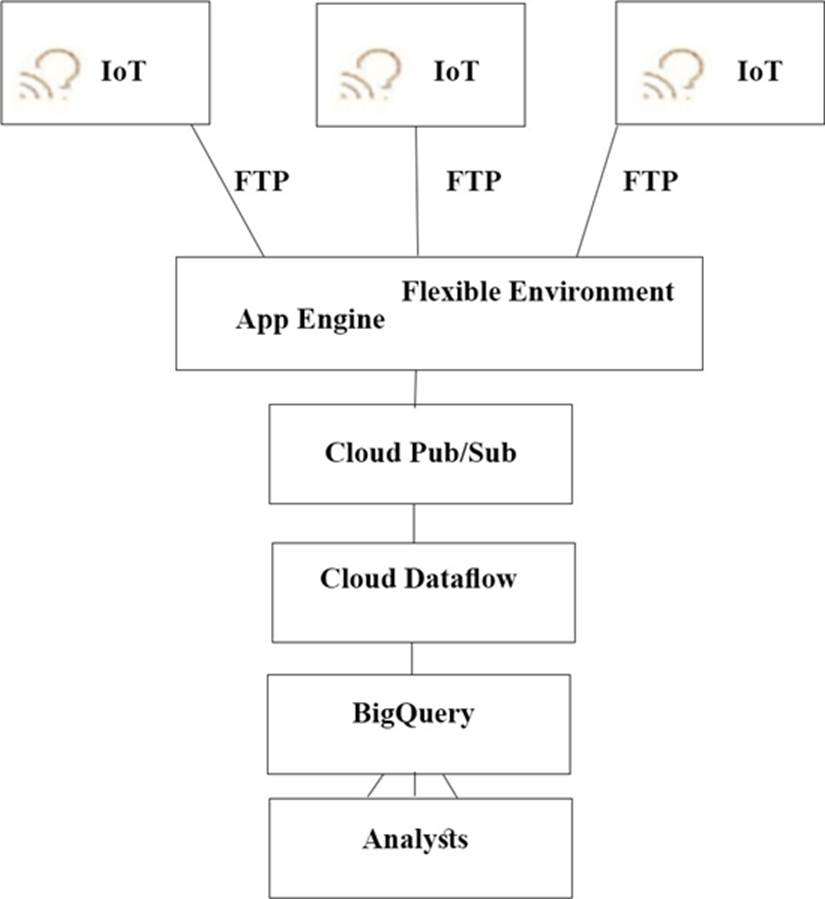
C)
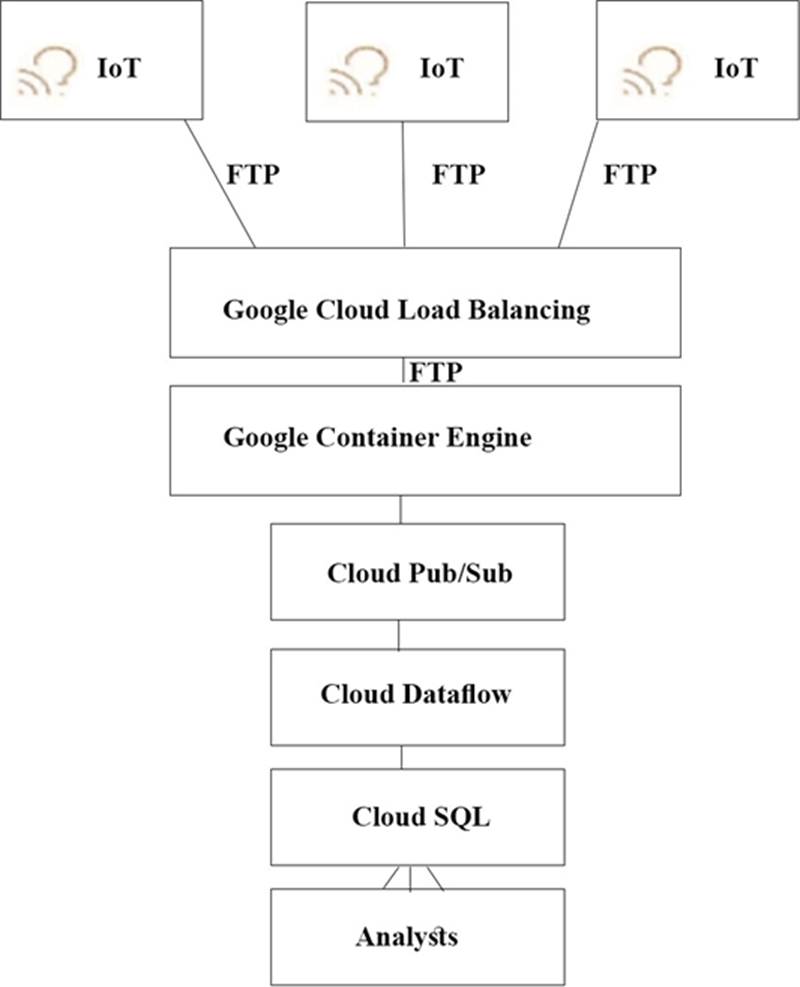
D)
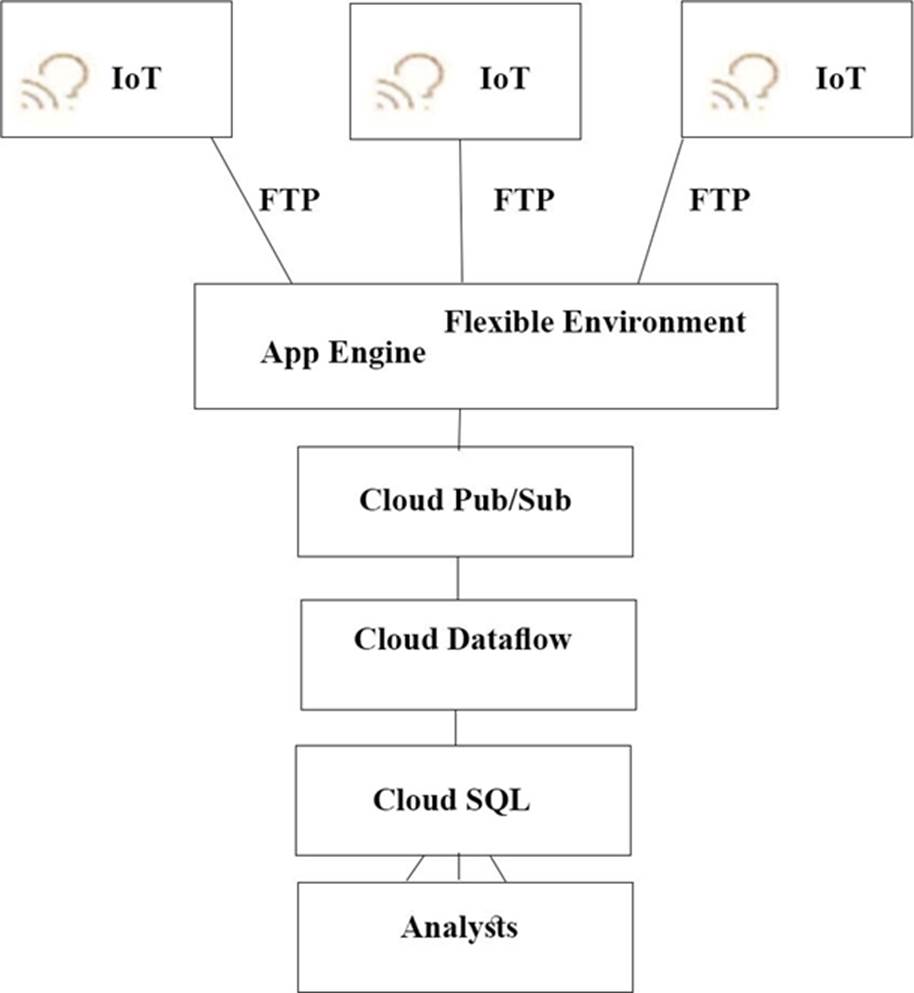
- A . Option A
- B . Option B
- C . Option C
- D . Option D
Latest Professional Cloud Architect Dumps Valid Version with 168 Q&As
Latest And Valid Q&A | Instant Download | Once Fail, Full Refund

